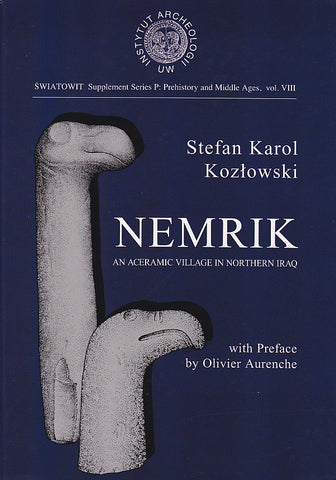Nemrik. An Aceramic Village in Northern Iraq
64,00 $
ISBN: 83-87496-63-4
Description: hardback, 117 pp. (29,5x21cm), CLXXIV plates, 29 figs
Condition: new
Weight: 1310g.
Stefan K. Kozlowski, Nemrik. An Aceramic Village in Northern Iraq, with Preface by Olivier Aurenche, Institue of Archaeology, Warsaw University, Warsaw 2002
Preface
1. Introduction
1.1. Six seasons
1.2. Scientific Staff
1.3. Iraqi Antiquities Organization and its representatives
1.4. Technical staff
1.5. Colleagues and friends
1.6. Collections of finds
2. The Site
2.1. Description
2.2. Fieldwork and laboratory methods
2.3. Sampling
2.4. Stratigraphy
2.4.1. Structures superposition
2.4.2. N-S cross-section
2.4.3. Stratigraphical division
2.4.4. Complex K
2.4.5. Complex KM
2.4.6. Conclusion
2.5. Chronology
2.5.1. Generalities
2.5.2. Beginning and end of settlement
2.5.3. K and KM stratigraphic complexes transition stage
2.5.4. Complex K
2.5.5. Layer KL
2.5.6. Phase IVb
2.5.7. Conclusions
3. Houses
3.1. Introduction
3.2. Plan and structure
3.3. Walls
3.4. Roof
3.5. Roof support
3.6. Furnishing the interior
3.6.1. Floor
3.6.2. Internal divisions3.7. Equipment
3.7.1. Burned houses
3.7.2. Equipment
3.7.3. Flint scatters in the houses
3.7.4. Cache of bladelets
3.7.5. At home and on the dump
3.8. Inhabiting the house
3.9. Stores
4. Burials
4.1. Introduction
4.2. Burials interspersed between the houses.
4.3. Burials under houses
4.4. Cemetery area
4.5. Tombs (= houses 6 & 10)
4.6. Head burials
4.7. Grave equipment
4.8. Arrowheads in graves
5. Urban layout
5.1. Phase V
5.1.1. Extent
5.1.2. Zones of activity
5.2. Phase IV
5.3. Phase III
5.4. Phase II
5.5. Phase I
5.6. Conclusions
5.7. Duration of house/village
5.7.1. Number of skeletons/individuals
5.7.2. Age structure
5.7.3. Family size
5.7.4. The Nemrik Generations
6. Lithic industry
6.1. Introduction
6.2. Raw materials
6.3. General technological structure
6.4. Cores
6.5. Flakes
6.6. Blades/bladelets
6.7. Reduction strategy/chaine operatoire
6.8. Blade sectioning
6.9. Inserts
6.10. Nemrik field flint tool type list
6.11. Inner structure of the tool assemblages
6.12. End-scrapers6.13. Retouched flakes
6.14. Burins
6.15. Truncations
6.16. Retouched blades. 6. 17. Perforators
6.18. Combined tools
6.19. Heavy duty tools
6.20. Arrowheads
6.22. Evolution of the industry
6.23. "Sickles" (cf. truncations and retouched blades)
6.24. Sickles function
6.25. Big-chocolate tools
6.26. Rare products / types
6.27. Tools of extraordinary size, meaning tools made at home and tools available on the market
6.28. Conclusions
7. Stone industry
7. 1. Introduction
7.2. Typological list of stone tools
7.2.1. List of types (after R. F. Mazurowski 1997)
7.3. Raw materials
7.4. Big Stone Implements (BSI) - introduction
7.4. 1. Querns
7.4.2. Mortars
7.4.3. Slabs
7.4.4. Concluding remarks on BSI
7.5. Small Stone Implements
7.5. 1. Balls / bolas
7.5.2. Perforated balls, / maceheads
7.5.3. Grinders
7.5.4. Specimens with flat working end / pounders and pestles
7.5.5. Celts /polished axes and adzes
7.5.6. Slotted stones
7.5.7. Phallic representations
7.5.8. Others
7.5.9. Stone vessels
7.5.10. Conclusion
8. The Gods from Nemrik
9. Small finds
9.1. Introduction
9.2. Clay pieces
9.2.1. Tokens
9.2.2. Figurines
9.2.3. Other clay objects9.2.4. Products of unfired clay
9.2.5. Conclusions
9.3. Stone pieces
9.3.1. Tokens
9.3.2. Small statuettes (?)
9.3.3. Jewelry/Ornaments
9.4. Giant needles
9.5. Shell ornaments
9.6. Objects of bone
9.7. Copper
9.8. General Conclusion
9.9. Additional remarks
10.Early Holocene Environment
10.1. Introduction
10.2. Pollen diagram
10.3. Charred plant remains
10.4. Charcoals
10.5. Fauna
10.5.1. Mammals
10.5.2. Birds
10.5.3. Molluscs
10.6. 19th and 20"' century descriptions of the local environment
10.7. TAVO Maps
10.8. The Early Holocene habitat near Nemrik
11.End
12.Tables
13.The basic bibliography of Nemrik
14.Plates and figures

